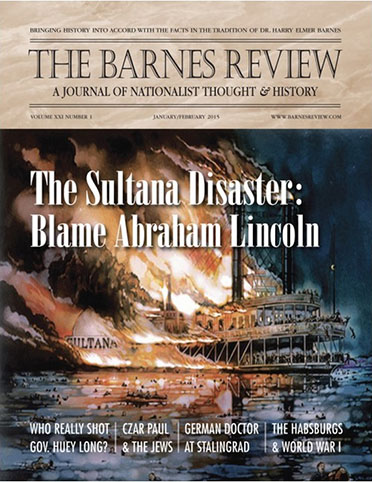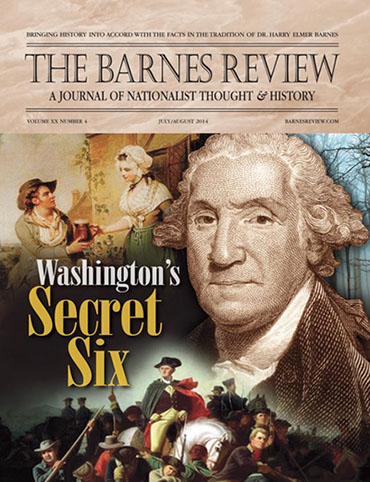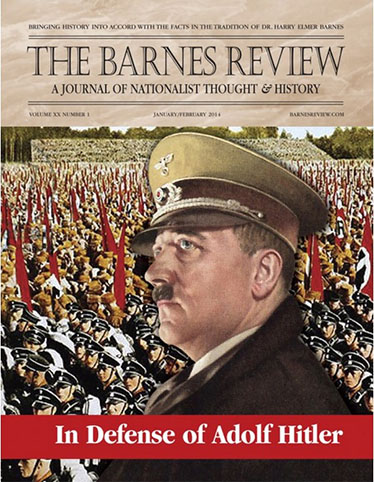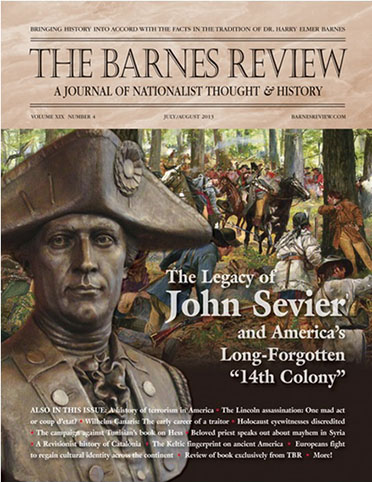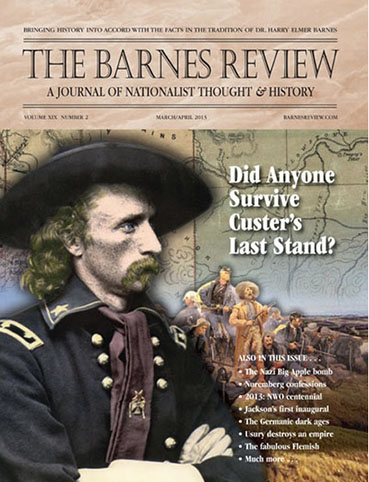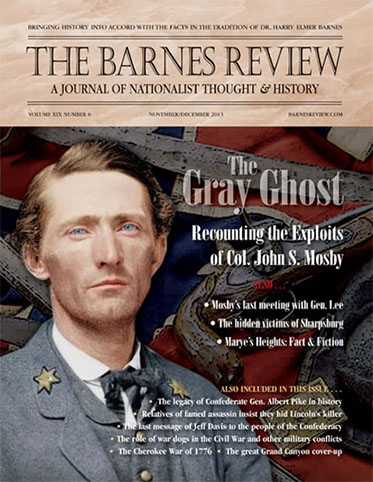
The Barnes Review, November/December 2013
$5.00 – $10.00
The Barnes Review
A JOURNAL OF POLITICALLY INCORRECT HISTORY
November/December 2013 ❖ VOLUME XIX ❖ NUMBER 6
TABLE OF CONTENTS
THE GRAY GHOST OF THE CONFEDERACY
MOSBY REMEMBERS ROBERT E. LEE
THE ANGEL OF MARYE’S HEIGHTS
THE FATE OF CIVILIANS AT ANTIETAM
RELATIVES INSIST THEY HID ASSASSIN
LONGFELLOW’S CHRISTMAS POEM
A REBEL GENERAL’S MASONIC LEGACY
JEFFERSON DAVIS’S LAST HURRAH
THE UNSUNG DOGS OF WAR
LOST CITY IN THE GRAND CANYON?
- Description
- Additional information
Description
The Barnes Review
A JOURNAL OF POLITICALLY INCORRECT HISTORY
November/December 2013 ❖ VOLUME XIX ❖ NUMBER 6
TABLE OF CONTENTS
THE GRAY GHOST OF THE CONFEDERACY
By E. Stanley Rittenhouse. Trained by dashing Rebel cavalry leader J.E.B. Stuart, a mentor to a young George S. Patton, U.S. consul to Hong Kong and an assistant attorney general in the U.S. Justice Department, John Singleton Mosby is well worth contemplating today.
MOSBY REMEMBERS ROBERT E. LEE
By John Singleton Mosby. The tactics of Confederate Col. John S. Mosby are still taught to military men today. But Mosby was also an excellent writer. Here TBR reproduces a portion of Mosby’s memoirs—first published in 1917—dealing with his memories of his supreme commander, Gen. Robert E. Lee.
THE ANGEL OF MARYE’S HEIGHTS
By John Tiffany. Even during the most heated of battles, some men never forget their humanity. Here is the legend surrounding one Confederate soldier who allegedly risked his own life several times during the Battle of Fredericksburg to bring water to wounded warriors in blue—his avowed enemies.
THE FATE OF CIVILIANS AT ANTIETAM
By Michael Collins Piper. War is hell, certainly for the soldiers, but we must never forget the civilian casualties of war, something many of us do overlook, mainly because America has not seen a real war on American soil for 150 years. In this article, TBR’s Michael Collins Piper details the effects of one battle—the Battle of Sharpsburg at Antietam Creek in 1862— upon the surrounding civilian populace. As you read this, imagine what America’s “smart bombs” are doing today in the Middle East to innocent civilians.
RELATIVES INSIST THEY HID ASSASSIN
By Emory A. Morgan. Since 2008, when TBR published its first article on the great escape of John Wilkes Booth, perhaps no other story has elicited such interest. Dozens of readers have forwarded information to us about the fate of Booth. In this issue, we revisit the topic, this time concentrating on those Booth family members who insist John Wilkes survived.
LONGFELLOW’S CHRISTMAS POEM
By Tom Stewart. Famed American poet Henry Wadsworth Longfellow, for all his glory, led a tragic life. And, while we are familiar with many of his greatest literary works, we did not know he was also the author of one of America’s most beloved Christmas carols and the circumstances surrounding its creation. Here is Longfellow’s Civil War tale.
A REBEL GENERAL’S MASONIC LEGACY
By Pete Papaherakles. Confederate Gen. Albert Pike had a checkered military history. Accused of inciting war crimes against Union soldiers, Pike—before and after the war—was a powerful influence on American Masonry. Some even say he was able to predict World War I and World War II. Still others insist Pike’s vision of a third world war—pitting Islam against Christianity—is happening now.
JEFFERSON DAVIS’S LAST HURRAH
By Jefferson Davis. Proud and stubborn until the end, Confederate President Jefferson Davis, even after the loss of Richmond, was sure the South could win the war. Here is his last message to the people of the Confederacy, delivered just five days before Lee surrendered to Grant at Appomattox Court House.
THE UNSUNG DOGS OF WAR
By Victor Thorn. Not only did a million men go to war during the War Between the States, but so did their pets and mascots, some providing real help and inspiration to their human comrades. Here TBR puts the spotlight on some of these amazing war dogs who served their country—and their owners— proudly during Lincoln’s great conflagration.
LOST CITY IN THE GRAND CANYON?
By Philip Rife. In the early 1900s, a respectable newspaper out West detailed the findings of a group of relic seekers who alleged they had found a cache of ancient artifacts in one of the hundreds of caves in the Grand Canyon. But did the Smithsonian spike the discovery for its own political reasons?
Additional information
| TBR Back Issue | PDF Copy, Print Copy |
|---|



